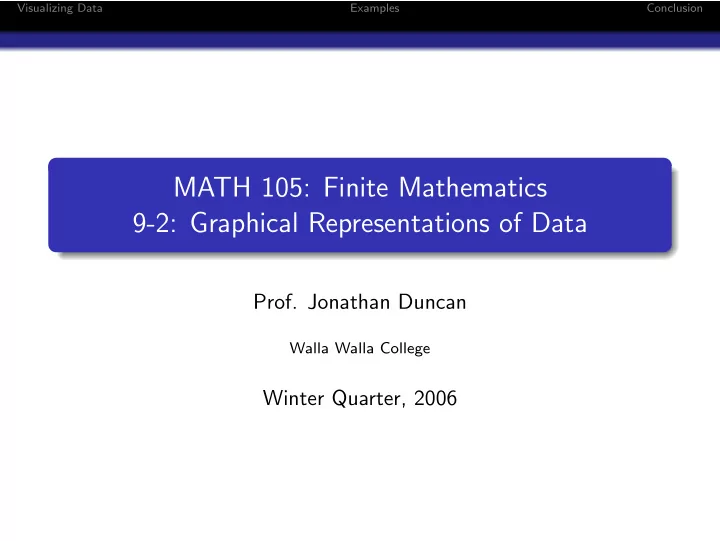

Visualizing Data Examples Conclusion MATH 105: Finite Mathematics 9-2: Graphical Representations of Data Prof. Jonathan Duncan Walla Walla College Winter Quarter, 2006
Visualizing Data Examples Conclusion Outline Visualizing Data 1 Examples 2 Conclusion 3
Visualizing Data Examples Conclusion Outline Visualizing Data 1 Examples 2 Conclusion 3
Visualizing Data Examples Conclusion Two types of Graphs Once we have collected the raw data, we need a way to display it so that it is easily understood. Tables can be helpful (we’ve used them in probability examples) as can graphs. Types of Graphs We will consider two types of graphs in this class: Bar Chart Data can be separated into categories Bars show the frequence of percent of data in each category Also separates data into categories Pie Chart Pie shows % of data in each category
Visualizing Data Examples Conclusion Two types of Graphs Once we have collected the raw data, we need a way to display it so that it is easily understood. Tables can be helpful (we’ve used them in probability examples) as can graphs. Types of Graphs We will consider two types of graphs in this class: Bar Chart Data can be separated into categories Bars show the frequence of percent of data in each category Also separates data into categories Pie Chart Pie shows % of data in each category
Visualizing Data Examples Conclusion Two types of Graphs Once we have collected the raw data, we need a way to display it so that it is easily understood. Tables can be helpful (we’ve used them in probability examples) as can graphs. Types of Graphs We will consider two types of graphs in this class: Bar Chart Data can be separated into categories Bars show the frequence of percent of data in each category Also separates data into categories Pie Chart Pie shows % of data in each category
Visualizing Data Examples Conclusion Two types of Graphs Once we have collected the raw data, we need a way to display it so that it is easily understood. Tables can be helpful (we’ve used them in probability examples) as can graphs. Types of Graphs We will consider two types of graphs in this class: Bar Chart Data can be separated into categories Bars show the frequence of percent of data in each category Also separates data into categories Pie Chart Pie shows % of data in each category
Visualizing Data Examples Conclusion Outline Visualizing Data 1 Examples 2 Conclusion 3
Visualizing Data Examples Conclusion Automobile Expenditures Example The following data represents the total amount spent on automobiles in the US in 1999. Numbers are in billions of dollars. Category Amount A New/Used Cars 200.2 B Tires and Accessories 49.3 C Gas and Oil 141.1 D Insurance 43.0 E Interest on Debt 40.6 F Registration and Fees 9.1 G Repairs 178.3 Construct a bar chart and pie chart using this data.
Visualizing Data Examples Conclusion Bar Chart Below is the bar chart for the previous example.
Visualizing Data Examples Conclusion Pie Chart Set-up Before we construct the pie chart, let’s re-examine the data. Example We determine percents and degrees for each category. Category Amount Percent Degrees A New/Used Cars 200.2 30.2% 109 ◦ B Tires and Accessories 49.3 7.5% 27 ◦ C Gas and Oil 141.1 21.3% 77 ◦ D Insurance 43.0 6.5% 23 ◦ E Interest on Debt 40.6 6.1% 22 ◦ F Registration and Fees 9.1 1.4% 5 ◦ G Repairs 178.3 26.9% 97 ◦ 661.6 100.0% 360 ◦
Visualizing Data Examples Conclusion Pie Chart Set-up Before we construct the pie chart, let’s re-examine the data. Example We determine percents and degrees for each category. Category Amount Percent Degrees A New/Used Cars 200.2 30.2% 109 ◦ B Tires and Accessories 49.3 7.5% 27 ◦ C Gas and Oil 141.1 21.3% 77 ◦ D Insurance 43.0 6.5% 23 ◦ E Interest on Debt 40.6 6.1% 22 ◦ F Registration and Fees 9.1 1.4% 5 ◦ G Repairs 178.3 26.9% 97 ◦ 661.6 100.0% 360 ◦
Visualizing Data Examples Conclusion Pie Chart Below is the pie chart for the previous example.
Visualizing Data Examples Conclusion Outline Visualizing Data 1 Examples 2 Conclusion 3
Visualizing Data Examples Conclusion Important Concepts Things to Remember from Section 9-2 1 Constructing Bar Charts 2 Constructing Pie Charts
Visualizing Data Examples Conclusion Important Concepts Things to Remember from Section 9-2 1 Constructing Bar Charts 2 Constructing Pie Charts
Visualizing Data Examples Conclusion Important Concepts Things to Remember from Section 9-2 1 Constructing Bar Charts 2 Constructing Pie Charts
Visualizing Data Examples Conclusion Next Time. . . Next time we will look at ways to take larger data sets and organize them into tables and charts which help us in analyzing the data. For next time Read section 9-3
Visualizing Data Examples Conclusion Next Time. . . Next time we will look at ways to take larger data sets and organize them into tables and charts which help us in analyzing the data. For next time Read section 9-3
Recommend
More recommend